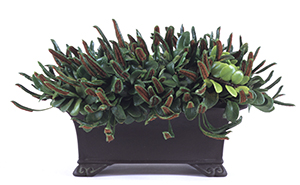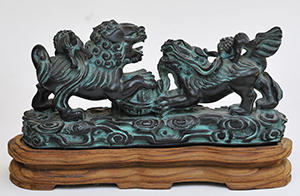Know Your Tree
Accessory Plants
by Lew Buller
If you plan to display your tree with an accessory at a club show, ask if there are any club rules about display. Some clubs have very strict rules. Small accessories are easily taken by curious visitors, so use accessories large enough they will not be hidden easily in a purse or pocket.
Small plants as accessories
Japanese Bean fern
The pot for the Japanese bean fern measures 4 ½” x 6” at the top and is the smallest pot I would use for accessory plants. The Japanese bean fern (Lemmaphyllum microphyllum) has spores on the underside of its leaves just as any other fern would have...
The brown pads on the leaves are the spores. It is easier to let the plant grow and divide it than to attempt to do anything with the spores. Like other ferns, it likes shade, moisture, and good drainage. It grows slowly; it may take two-three years to double in size. My mother plant is used as an accessory in bonsai displays; periodically, I divide it and pass it around to friends.
Garden centers often have a collection of small plants which can be potted up in pots large enough for safe display. Here are a couple of my favorites:
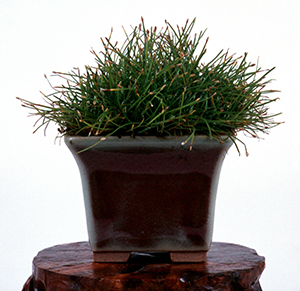
Miniature rush
Miniature rush (Eleocharis radicans) likes very moist growing conditions. The tiny seed heads blow around and germinate easily; the plant also spreads by roots. The roots like the heat at the edge of a pot, so they are likely to form a border around the edge of the pot. It dies down every other year and may need to be replaced, but it is easy to grow and keep in a separate small pot.
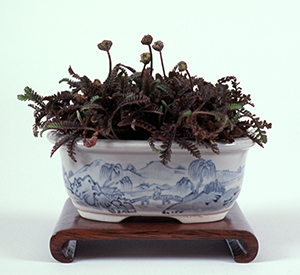
Black Brass Buttons
Black Brass Buttons, a hybrid of ‘Pratt’s Black’ and Cotula leptinella, may grow to be a little over one inch tall. It grows at a moderate pace, however, and can be divided if it outgrows its space. The small round balls on the stems are the buttons. In spite of its soft feathery look, it is used as ground cover where there is limited foot traffic. It needs part shade–full sun is too much–and the same well-drained soil used for bonsai.
Avoid baby tears–Soleirolia soleirolii has been declared a pest in England–as the roots reach to the bottom of the pot and vegetation soon takes over the entire surface.
Stones as accessories–See “Stones” in the Know Your Tree Series for examples of stones that can be used as accessories. The same warning applies: don’t use stones small enough they can be taken by curious viewers.
Small trees as accessories
A small tree next to a larger bonsai will serve as a contrast and emphasize the larger tree. The examples shown here are ones that grow well in the San Diego subtropical climate but you can pick and choose from trees that do well in your climate.
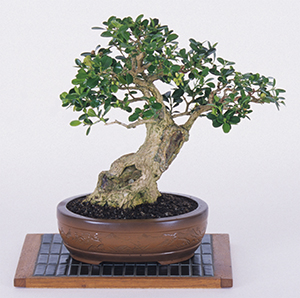
Scarred by gardeners trimming the hedge, this little boxwood is a true survivor. It responds well to trimming (boxwoods in hedges are trimmed severely to create a dense canopy) and requires no special care. Branches can be wired while they are small; as they grow larger, they become very stiff.
A favorite of mine, the Juniperus sargentii ‘Kishu’ grafted on San Jose juniper, makes a very attractive tree when it is small. It grows slowly, retaining its deep green dense foliage.
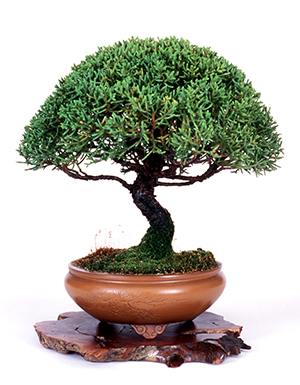
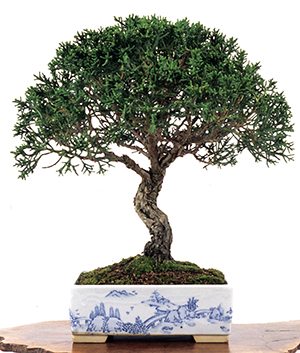
Art objects as accessories–The standard warnings apply: check club rules; don’t use small items. The miniature stone lantern is 7 1/4” tall and I show it under a plexiglass cover borrowed from the Mingei International Art Museum.
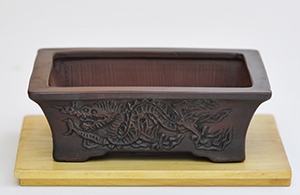
I have yet to show the Japanese pot and its protective box made of ginkgo biloba wood. Handmade and signed by the artist, it is a gift.
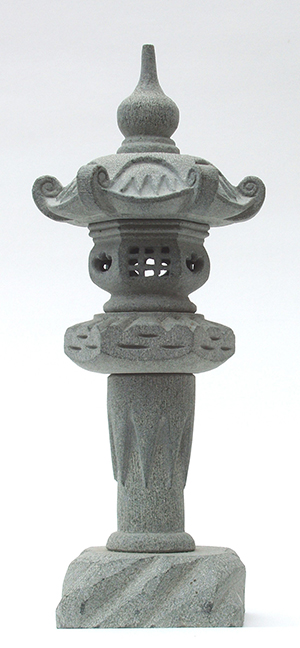
The dog-lions1 in the steatite carving tell you this was made in China, most likely Taiwan. My trees are not Chinese-style; no one at the club complained when I showed it. One member was curious enough t pick it up and check it. When he found no mold marks, he declared it to be the real thing. It could, however, be a resin casting from a rubberized mold.
Accessories for Chinese and Vietnamese bonsai
You may never have a need for one of these, but it is interesting to know about the different cultures. After all, China is accepted as the origin of bonsai, although there is some evidence that Ayurvedic physicians in India grew their medicinal trees in pots for easy harvesting. The Chinese art traveled through Korea to Japan, where it was stripped of its ornamentation by the Zen Buddhists who took up the art.
The Chinese occupied Viet Nam for about 900 years and there was a considerable exchange of cultural values. Indonesia also has living art similar to these two countries.
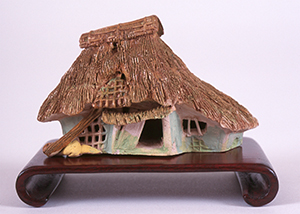
Confucius meditating under a tree is a common theme. The figure is tiny, compared to the accessories shown above, perhaps because the amount of space in the pot is limited compared to the amount of space available to self-standing accessories. The first Asian accessory shown is Japanese, an antique brought back to the U. S. by a woman who spent many years in Japan. It is a deserted farmhouse, meant for a tray landscape modeled after the Chinese.
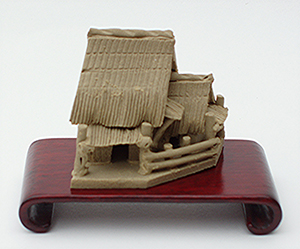
Only 2” tall, the unpainted Chinese clay hut is very detailed and is probably meant for a family. A fisherman’s hut would be a simple one-room affair, a place to stay dry and get ready for the next day of fishing.
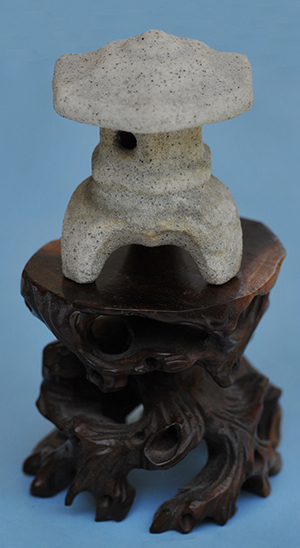
The small stone lantern appears to be in the Japanese style but I believe it was made in China. It would go with either style of tree. The intricate stand, carved to represent roots, is Japanese and competes with the lantern for attention.
(Endnotes)
1. According to Wikipedia, the lions are always presented in pairs, a manifestation of yin and yang, the female representing yin and the male yang. The male lion has its right front paw on a type of cloth ball simply called an “embroidered ball” (xiù qiú,), which is sometimes carved with a geometric pattern (coincidentally, resembling the figure called “Flower of Life” in the New Age movement). The female is essentially identical, but may have a cub under the closer (left) paw to the male, representing the cycle of life. Symbolically, the female fu lion protects those dwelling inside, while the male guards the structure.

